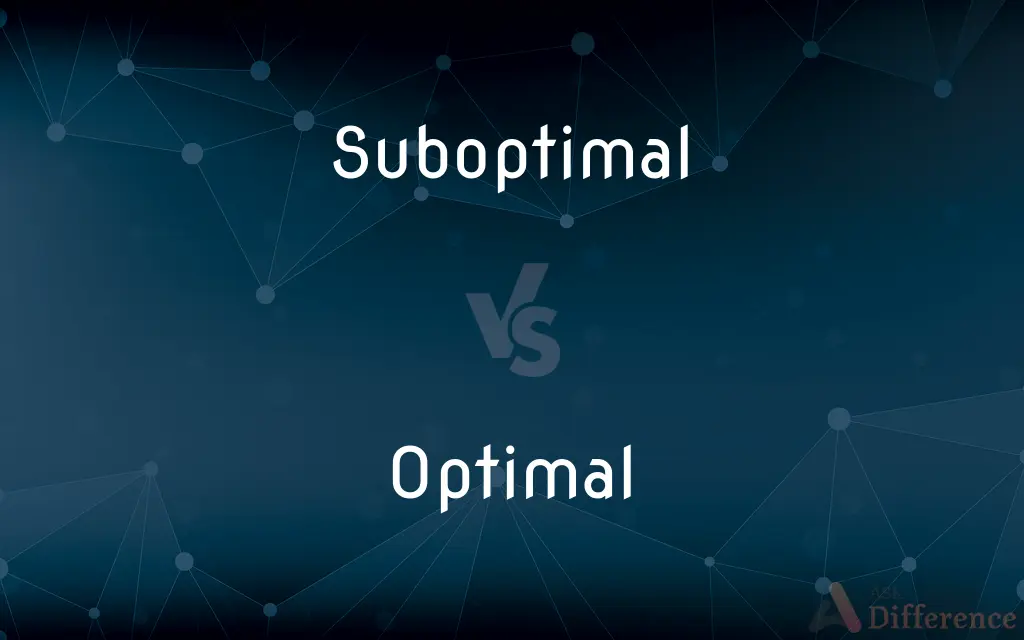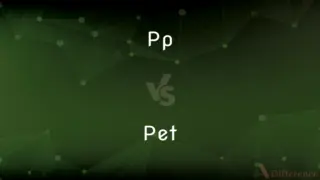Suboptimal vs. Optimal — What's the Difference?
By Fiza Rafique & Maham Liaqat — Updated on March 19, 2024
Optimal refers to the best or most favorable condition, while suboptimal signifies a level below the best, often inadequate or less efficient.

Difference Between Suboptimal and Optimal
Table of Contents
ADVERTISEMENT
Key Differences
Optimal conditions or solutions represent the pinnacle of efficiency and effectiveness in a given scenario, achieving the highest possible performance or outcome. Suboptimal, on the other hand, describes conditions or solutions that fall short of this ideal, often resulting in lower efficiency or effectiveness.
In terms of decision-making, an optimal decision is one that leads to the best possible result under the given circumstances, considering all constraints and resources. A suboptimal decision, while it may still lead to a positive outcome, does not fully exploit the available resources or opportunities, leading to a less favorable result.
From a health perspective, an optimal health status implies being in the best possible physical and mental condition, characterized by the absence of disease and a high level of fitness and well-being. Suboptimal health, conversely, indicates a state where one or more aspects of health are not at their best, potentially due to lifestyle choices, environmental factors, or genetic predispositions.
In the context of performance, whether in sports, academics, or professional settings, optimal performance denotes achieving the highest standards and surpassing goals, often through rigorous training, strategy, and dedication. Suboptimal performance, meanwhile, signifies a level of achievement that, while perhaps satisfactory, does not meet the highest standards or potential of the individual or team.
When considering environmental sustainability, optimal practices are those that maximize resource efficiency, minimize environmental impact, and contribute to the health of the planet. Suboptimal practices, in contrast, may only partially address these goals, leading to greater resource use, higher emissions, or lessened ecological health.
ADVERTISEMENT
Comparison Chart
Definition
Below the best, often inadequate
Best or most favorable condition
Decision-making
Results in a less favorable outcome
Leads to the best outcome
Health Status
Not at the best possible health status
Best physical and mental condition
Performance
Satisfactory but below potential
Achieving the highest standards
Environmental Sustainability
Only partially addresses goals
Maximizes resource efficiency
Compare with Definitions
Suboptimal
Less than the best possible.
Suboptimal lighting conditions affected the quality of the photos.
Optimal
Best possible outcome.
Optimal health results from a balanced diet and regular exercise.
Suboptimal
Not achieving full potential.
The team’s suboptimal performance led to their loss in the finals.
Optimal
Most favorable or efficient.
The optimal route saves both time and fuel.
Suboptimal
Conditions that do not meet ideal standards.
The suboptimal climate conditions challenged the farmers.
Optimal
Highest degree of effectiveness.
Achieving optimal performance requires consistent training.
Suboptimal
Below the desired health status.
Suboptimal nutrition can lead to health issues over time.
Optimal
Perfectly suitable for a specific purpose.
The software offers optimal solutions for data analysis.
Suboptimal
Inefficient or inadequate solutions.
The suboptimal layout of the office slowed down workflow.
Optimal
Ideal conditions for growth or success.
The greenhouse provides optimal conditions for exotic plants.
Suboptimal
Worse than optimal.
A quickly produced suboptimal solution to a problem is often more useful than an optimal one that takes a long time to produce.
Optimal
Most favorable or desirable; optimum.
Optimal
The best, most favourable or desirable, especially under some restriction.
Finding the optimal balance between features and price is a common problem.
Optimal
(artificial intelligence) Describing a search algorithm that always returns the best result.
Optimal
The best of its kind
Optimal
Best possible; most desirable; optimum; as, the optimal concentration of a drug.
Optimal
Most desirable possible under a restriction expressed or implied;
An optimum return on capital
Optimal concentration of a drug
Common Curiosities
What does optimal mean?
Optimal refers to the best or most favorable condition, achieving the highest efficiency or effectiveness.
Can suboptimal performance be improved to optimal?
Yes, through analysis, strategy adjustments, and addressing specific shortcomings.
Why is aiming for optimal health important?
It maximizes well-being, prevents diseases, and enhances quality of life.
What does suboptimal mean?
Suboptimal signifies a level below the best, often inadequate or less efficient.
Are suboptimal solutions always unacceptable?
Not necessarily; they may be interim steps towards achieving optimal conditions.
How does one achieve optimal performance?
Through dedicated training, continuous improvement, and leveraging strengths.
Is optimal always the most expensive option?
Not always; in many cases, optimal solutions can be cost-effective in the long term.
Can environmental practices be moved from suboptimal to optimal?
Yes, by adopting more sustainable methods and technologies.
How do lifestyle choices affect optimal health?
Healthy lifestyle choices directly contribute to achieving and maintaining optimal health.
Why is achieving optimal environmental sustainability challenging?
Due to complex factors like economic pressures, technological limitations, and global coordination.
How can one identify suboptimal conditions?
By comparing current outcomes with the highest achievable standards or desired results.
What factors contribute to suboptimal decision-making?
Lack of information, poor resource management, or insufficient planning.
Can a suboptimal start lead to an optimal finish?
Yes, with the right adjustments and efforts, an optimal outcome is still achievable.
What role does feedback play in transitioning from suboptimal to optimal?
Feedback provides insights into areas of improvement and helps refine strategies.
How can businesses move from suboptimal to optimal operations?
Through process optimization, technology upgrades, and focusing on best practices.
Share Your Discovery

Previous Comparison
Tyred vs. Tired
Next Comparison
PP vs. PETAuthor Spotlight
Written by
Fiza RafiqueFiza Rafique is a skilled content writer at AskDifference.com, where she meticulously refines and enhances written pieces. Drawing from her vast editorial expertise, Fiza ensures clarity, accuracy, and precision in every article. Passionate about language, she continually seeks to elevate the quality of content for readers worldwide.
Co-written by
Maham Liaqat













































